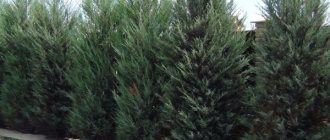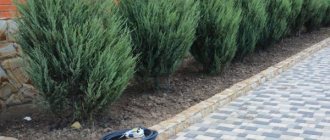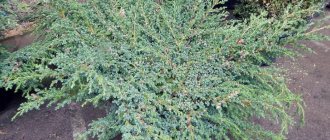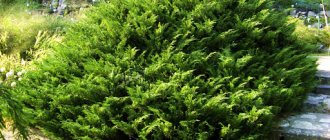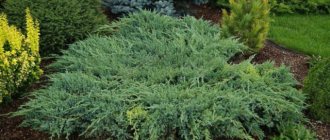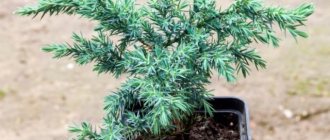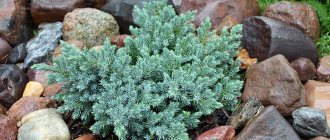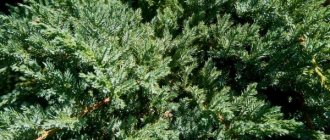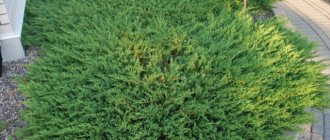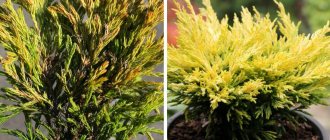Description of juniper Blue Arrow
The Blue Arrow variety does not lose needles in the lower part of the trunk for a long time.
This juniper is native to North America, it grows on rocks, which is why it is called rocky. Many varieties have been developed, one of the best is Blue Arrow. Its name means "Blue Arrow" and its appearance matches it. The needles have a bluish-blue tint - this is noticeable if the plant is planted in good lighting.
The Blue Arrow juniper differs from its parent variety in having shorter branches that are resistant to snow accumulation. By rubbing the needle-shaped and scaly needles between your fingers, you can feel a special pleasant aroma. The plant blooms in May, then produces cones with a bluish coating and seeds inside.
Frost resistance of juniper Blue Arrow
This is a frost-hardy plant that is grown from zone 3b and warmer. An adult tree will not need shelter in winter; it can easily tolerate frosts from -34 to -37 °C.
Diameter and height of Blue Arrow juniper
The crown shape is columnar, the conifer is narrow and vertical. In the temperate zone, in the first decade the tree grows to a height of up to 3 m, the crown width reaches 0.5-0.7 m.
Growth rate of Blue Arrow juniper
The average annual growth of coniferous shoots is about 15 cm. The speed of this process depends on the planting site and the quality of the soil. Care is important at first, while the roots develop and grow in depth and breadth.
How long does Blue Arrow juniper live?
The lifespan of juniper is more than a thousand years. Young seedlings are especially vulnerable in February and March. Then the plant develops a powerful root that goes deep, and it perfectly resists drought, frost, and disease.
Description of the blue conifer
Juniper juniperus scopulorum blue arrow is an evergreen shrub with a sharp tip and expressive blue needles. It belongs to the cypress family. Translated from English, the name of the plant means “Blue Arrow”. Its usual height is from two to three meters, but some specimens reach five meters in height. The width of the bush is only 70 cm.
It has rigid vertical shoots that fit tightly to the trunk. They form a graceful arrow-shaped plant shape. The branches grow almost from the ground itself - this is one of the advantages of Blue Arrow. Over time, they do not die off, like most other conifers, but retain an attractive appearance for a very long time. The graceful shape of the plant does not change with age and under the influence of weather conditions.
Juniper virginiana Blue Arrow is an unpretentious plant, undemanding to the composition and moisture of the soil. Its advantages:
- good frost resistance, which allows you to grow juniper in the northern regions;
- good drought resistance;
- compact crown structure, thanks to which Blue Arrow does not need frequent trimming;
- juniper gets along well with other types of plants - deciduous and coniferous.
Juniper Blue Arrow in landscape design
Blue Arrow is planted along the fence and next to other conifers.
Examples of placing juniper on the site:
- as a single plant to create an accent - thanks to the beautiful blue needles and vertical crown it will immediately attract attention;
- groups of 3-4 pieces. together;
- make hedges out of it;
- grow in a container.
Advice! Since ephedra does not grow very quickly, it makes good for all kinds of topiary forms - nivaki.
Features of reproduction
This variety can be propagated in two ways - by seed and using cuttings.
Most gardeners prefer the second method. It is more productive, faster and makes it possible to obtain young seedlings with all the varietal characteristics of the mother shrub.
Propagation by cuttings is carried out in the summer - in the middle or end of July. To do this, use healthy juniper that is at least five years old.
- Cut the apical shoots 15-20 cm long with a piece of lignified bark. At the bottom of each branch, they remove needles and sprouts.
- The blanks are immediately planted in the soil so that the living part below does not dry out and takes root successfully. Planting is carried out in any capacious container - seedling boxes or plastic containers. The main thing is that there are drainage holes at the bottom of such containers to drain excess liquid.
- The cuttings are placed at an angle of 40-45°C to a depth of 4 cm. Then they are irrigated with warm water, covered with a transparent film or half of a plastic bottle and placed in a warm place with diffused daylight.
For everything to be successful, the plantings need to be given competent and timely care, which includes regular irrigation, weed removal, surface loosening, ventilation and providing heat at 21-23°C.
Cuttings are carried out in the summer
Rooting will take 2 to 3 months. As soon as vegetative buds appear on the shoots, the shelter can be removed and the temperature reduced to 18-19°C.
The recommended time for transplanting young specimens into open ground is one and a half years after rooting. If planted earlier, many of them may not take root due to a weak root system.
Propagation of juniper Blue Arrow
The plant is propagated by seeds and cuttings. In the latter case, all varietal characteristics are preserved, and the seedling develops faster. Cuttings are the most common method of propagating Blue Arrow rock juniper.
Cuttings of Blue Arrow juniper
The best results are obtained by spring rooting of cuttings.
Semi-lignified shoot tips are harvested, leaving a “heel” at the end - old bark and wood. The needles are removed from the bottom of the cutting and immediately placed in a prepared soil mixture of sand and peat.
The cuttings are planted in small plastic containers or wooden boxes, then placed in a greenhouse in dim, diffused light, regularly watered and sprayed. Rooting occurs in approximately 2-3 months. Young seedlings are planted in a school for growing.
Landing rules
This crop does not tolerate heat and wind well, so you need to choose a sunny place for it with some shade and protection from drafts.
In the sun, juniper will quickly turn yellow and dry out.
The soil
Blue Arrow grows well in acidified, loose and light soil. Therefore, before planting, the soil should be sprinkled with peat, sand (two buckets each), and pine sawdust (bucket) per 1 m².
Then the area is dug up, leveled and watered. The site is prepared 2 weeks before the planned landing.
The optimal time for planting seedlings is the end of April or the beginning of May.
Preparation of seedlings
You can purchase planting material that, when grown, will reveal all the varietal characteristics of the mother bush, at a specialized nursery.
Alternatively, you can use seedlings grown from your own plant using cuttings.
When buying bushes, you should follow some rules:
- you need to choose specimens over 3 years old and only with a closed root system, so the risk of it drying out is minimized (they are sold in special containers or with a lump of earth wrapped in burlap);
- in strong and healthy plants, the above-ground part has a uniform bluish color of needles with a brown trunk and shoots without any spots, cracks, mold or rot;
- the optimal crown height is 0.6-0.7 m.
Landing technique
Planting material must be of good quality
Taking into account the small size and compact shape of blue arrow juniper, the following planting scheme is used to create a hedge - 50x50 cm.
The depth of the hole should be 2 times greater than the earthen ball with roots. Broken brick, pebbles or crushed stone are placed at the bottom. Then a nutritious mixture of turf soil, peat, sand and pine sawdust, mixed in equal quantities, is filled in halfway. Additionally, add one handful each of nitrophoska, superphosphate and potassium sulfate.
Lower the earthen ball, fill the voids, trample down the tree trunk area and spill with warm water - 5 liters per seedling.
To protect the roots and soil from rapid drying out, the area around the trunk is mulched with peat or pine chips.
Planting and caring for juniper Blue Arrow
A seedling is purchased from a nursery, choosing a plant with a healthy bluish-green crown. To make the Blue Arrow juniper look good, it is best to place it in a sunny place. It is recommended to choose a part of the garden where there is no draft or wind. Ephedra can be planted at any time of the year, except winter, but it takes root best in the spring.
Landing algorithm:
- Dig a hole 2-3 times larger than the volume of the container in which the seedling developed.
Perennials are bought in containers with a closed root system
- Fill it with a loose nutritious and fertile mixture.
- Excessive moisture is harmful to Blue Arrow juniper, so be sure to make a drainage layer at the bottom of the planting hole.
Drainage is poured at a height of 15-20 cm
- Take the seedling out of the container without destroying the earthen ball, place it in the hole and cover it with soil.
The soil around the seedling is slightly compacted
- After planting, carry out abundant watering. When the moisture is absorbed, moisten again. At the end, the tree trunk circle is mulched.
Important! When planting, do not bury the root collar. It’s also not a good idea to plant the plant too high; its roots will dry out, which will slow down its development.
Characteristics of the variety
Blue Arrow juniper is a plant of the Cypress family. It belongs to the evergreen shrubs, has a compact, elegant shape and is suitable for growing in the tiniest areas, because does not require much space.
External parameters
The average height of young plants is about 3 m, adult specimens are from 4 to 5 m.
Slowly forms growth - up to 15 cm per year. The needles are beautiful - bluish in tone, sometimes with a blue tint, the needles are soft.
The crown is narrow, columnar, consists of rigid, erect shoots that fit tightly to each other.
Regions and cost
The description of the needles includes several advantages - high resistance to severe frosts, drought resistance and high immunity against diseases.
Therefore, it is suitable for almost all regions of our country - the Moscow region, the Middle, Central, Northern zones and Siberia, provided there is good shelter for the winter.
The price of vertical juniper Blue Arrow depends on the size of the seedling:
- 2-2.2 m – 4200 RUR;
- 2.2-2.5 – 9300 rub;
- 2.5-2.7 – 12,000 rub.
Caring for Blue Arrow rock juniper
For the first 2-3 years, juniper needs abundant watering until the roots go deep. The frequency depends on the condition of the root system, climate and soil structure. Mulch greatly simplifies maintenance; it prevents the growth of weeds, prevents overheating of the soil in the summer, and protects against freezing in the spring.
Blue Arrow varieties do not require frequent pruning or fertilizing. Compost or Kemira is used as fertilizer once a year, and sanitary pruning is carried out in early spring.
Watering and fertilizing schedule
The Blue Arrow variety is quite drought-resistant, but regular moderate watering is required in the first months of cultivation. When the plant is well rooted and has started to grow, you can moisten it less often. If the soil is sandy, watering is done in small portions, but more often. Rock juniper Blue Arrow benefits from sprinkling, which is carried out in the evening in the summer.
If humus and peat have been added to the seedling in sufficient quantities, feeding Blue Arrow juniper is not necessary in the first year. You should not apply fertilizers with a high nitrogen content to a young plant; it needs phosphorus-potassium compounds in order to take root well.
Pruning Blue Arrow juniper
Juniper branches grow vertically and require little pruning. Even with heavy snowfall in winter, they do not break, maintaining their shape. The Blue Arrow variety shrub can be trimmed the next year after planting, removing broken or dried branches, before young buds appear in the spring.
Mulching, loosening the soil
The lack of mulch is the most common mistake made by inexperienced gardeners when growing junipers. Thanks to a mulching layer about 5 cm thick, moisture in the soil is retained longer, which is especially important for a recently planted plant that still has a weak root system. Organic mulch - pine bark, sawdust, peat - helps improve the structure of the soil and add nutrients to it. The soil remains loose, and more adventitious roots form on the plants.
Shelter for Blue Arrow rock juniper for the winter
In autumn, plants require moisture-recharging irrigation and fertilizing with phosphorus-potassium fertilizers. After heavy snowfall, shake the snow off the branches to prevent them from breaking.
Important! To protect against sunburn, Blue Arrow juniper has been covered with air-permeable material, such as burlap, since January.
In the first years, the seedling needs winter shelter
Reproduction
Rock juniper can be propagated by seeds or cuttings. Gardeners, as the easiest method, often choose the cutting method. To do this you need:
- cut off young shoots in spring;
- clean them from the needles from below;
- treat with a rooting stimulating agent;
- place in a box filled with peat substrate;
- transfer the box to a greenhouse, where the air temperature is from 18 to 23 degrees Celsius;
- in the fall, after complete rooting, young seedlings are transplanted into separate containers.
In this way, the Blue Arrow variety can be grown for 2-3 years, and then transplanted to an open place. During the entire period of growth of juniper in a container, it is necessary to provide watering as the soil dries out.
Propagation by seeds is not popular, as this process is very long and labor-intensive. It takes about 5 years and does not always end successfully.
Pests and diseases of Blue Arrow juniper
The presence of pests is often indicated by yellowed and dried needles. A careful examination of the juniper can reveal them - mealybugs, scale insects, and aphids. Larvae and adult females suck sap from young branches of a coniferous plant. As a result, growth is greatly retarded, and the needles on the affected shoots dry out and fall off. When pests are detected, the plants need to be treated. For this use:
- "Calypso";
- "Confidor Extra";
- "Aktaru".
The tree trunk circle also needs to be treated. One-time use of drugs kills only young individuals, and after some time new ones hatch. Therefore, the treatment is done several times every 1-2 weeks. Usually, spraying twice is sufficient. Mealybugs and aphids are afraid of moisture; evening sprinkling of the needles in the summer will prevent infestation of juniper by pests.
Overmoistening of the soil can provoke the appearance of fungal diseases and root rot. For treatment and prevention, the juniper tree trunk is sprayed with a fungicide. Use a solution of "Fundazol".
To prevent diseases of the above-ground part of the plant, the crown is treated with copper-containing preparations - “Hom”, Bordeaux mixture (1% solution).
Why does Blue Arrow juniper turn yellow and dry out, what to do
Juniperus virginiana Blue Arrow can turn yellow and dry out in both spring and fall. To help the plant, it is necessary to find out the cause of this phenomenon. There may be several of them:
- improper planting with deepening of the root collar;
- presence of pests;
- fungal diseases;
- sunburn (appears on the plant on the south side);
- seasonal shedding of conifers in autumn and spring.
Dry needles most often appear in the lower part of the trunk, inside the crown. This is an inevitable phenomenon that occurs even with good care. Old needles turn yellow in that part of the crown where light does not penetrate well. Dried branches need to be carefully cut off at the base of the trunk; new shoots will appear in their place.
Dry needles can also be caused by sunburn in early spring. Young seedlings are especially prone to damage; they require shading or shelter in the second half of winter. To restore an already damaged plant, it is watered with warm water in the circle around the trunk, the dried needles are cut off with pruning shears, once a week in the evening the crown is sprayed with “Epin” or “Zircon” and the soil is shed. Once every two weeks, treat with iron chelate. Be sure to sprinkle the crown in the evening.
Growth stimulants help conifers recover after burns
This care is continued for 4-8 weeks depending on the condition of the plant. Then it is enough to apply mineral fertilizers and some kind of growth stimulator once a month. With this care, by autumn the crown will begin to recover.
Important! A plant that has been burned will be weakened, so preventive treatments against diseases and pests are necessary.
Diseases and pests
The Blue Arrow variety is highly resistant to various diseases, but still, there are cases of infection with some of them. The most common diseases of rock juniper:
- rust. The tree is infected with a fungal infection. It appears as bright orange growths on the branches of the plant. The appearance of the juniper loses its former beauty, the plant begins to dry out. You can get rid of this scourge by pruning the affected branches and treating the juniper with fungicidal preparations. Repeat the procedure every 12-14 days until complete cure. This disease can be avoided if you plant Blue Arrow juniper away from fruit trees and carry out preventive treatment in time;
- chlorosis. It happens that the tree loses its brightness of color, the needles turn yellow and fall off. Despite the plant’s resistance to any soil composition, too alkaline soil composition or unsuitable microflora can lead to such consequences. The same signs may indicate highly polluted air in the area where Blue Arrow juniper grows.
The most common pests of Rock Juniper are:
- aphid. The Fitoferm product will help get rid of it. The tree must be sprayed and the procedure repeated after two weeks;
- mining moth. The drug “Decis” will help destroy the pest. After treatment, spraying must be repeated after 10-12 days;
- spider mite The drug “Karate” will help you get rid of it;
- scale insect The pest dies from the drug "Artserida". It is necessary to process several times until the insect is completely destroyed every 2 weeks.
General information
Description and features of rock juniper
The roots of a coniferous plant are no different from other rocky species. The root system branches and is located on the surface. Juniper is a long-lived plant and can reach 300 years of age.
One of the features of Blue Arrow is its frost resistance. Shelter is not needed even at a temperature of 28-30 degrees. The lower part of the needles is well preserved, which increases the decorative value of rock juniper. All shoots stretch upward, they are pressed tightly against the trunk, rigid enough not to break during strong gusts of wind and snow drifts.
Important! In terms of growth rate, juniper can be considered average. It grows by 20 cm per year, and in volume by 5 cm.
Despite the stiffness of the shoots, the needles are quite soft, with a bluish tint and a steel tint. Mature juniper has cone-like blue berries with a silvery coating on its branches.
The coniferous plant contains esters and phytoncides that protect the plant from fungi and other diseases. Coniferous oils are useful as aromatherapy for colds.
Cossack species or Juniperus sabina
Juniperus sabina
Cossack species of juniper or Juniperus sabina
- One of the most stress-resistant species, growing freely in Europe and Asia.
- The varieties are resistant to temperature changes, severe air pollution, high and low temperatures.
- A distinctive feature has become the reason for the frequent planting of the plant along the roads of megacities.
- The creeping shrub reaches a maximum height of 1.5 meters.
- Dark green, dense needles form a spreading crown.
- Color may vary depending on the variety.
- When choosing a plant for planting in a summer cottage, it is necessary to take into account its toxic qualities.
Tamariscifolia or Tamariscifolia
Tamariscifolia
Variety Tamariscifolia or Tamariscifolia
- This popular variety of perennial plant is distinguished by a spreading, dense, squat crown.
- An undemanding plant easily takes root even in poor soils.
- In the wild, it is found on steep cliffs and at an altitude of up to 3.5 meters above sea level.
- The stress-resistant plant reaches a height of up to two meters.
- Needle needles retain their greenish-blue color all year round.
- Ripe bluish-green cone berries are not suitable for consumption and are poisonous.
Blue Donau or Blue Donau
Blue Donau
Blue Donau or Blue Donau
- The maximum height of the bush reaches three meters.
- The variety is distinguished by the unusual blue color of its small needles.
- In winter, the crown changes color and acquires a green or purple tint.
- The plant is not fussy; a novice gardener can handle cultivation and care.
- By two years, the cones acquire a bluish color similar to pine needles.
- The plant tolerates urban conditions well and is resistant to weather changes.
Landing Features
The landing area must be spacious with good lighting. Seedlings with closed roots can be replanted in any season of the year. With the bare root system, they are moved to open ground in early spring, when the soil is already well warmed up.
For planting, dig a hole twice the size of the seedling's rhizome.
At what distance to plant from each other?
Seedlings take root well when given enough space. The distance between low-growing varieties should be at least 50 cm, between giants - 2 meters.
Creeping species are planted even further apart because they grow greatly in diameter. In order for them to form a dense carpet, the distance between the bushes should be 1–1.5 m.
Preparation of seedlings
Before lowering the roots of the plant into the ground, it is recommended to soak them in a bucket of water for 2 hours. Adult seedlings (from 4 years old) are grown in nurseries, but they are more difficult to plant, since they do not take root in a different substrate as quickly as young ones.
Before planting the bush in open ground, the root system with a ball of earth is kept in a bucket of water for 2 hours. It is recommended to treat exposed roots of seedlings with root formation stimulants, for example, Kornevin.
Further care
All plant care is simple and consists of several manipulations.
Watering
Vertical juniper blue arrow does not need frequent watering - it is better to underwater it than to overwater it. But in the first 10 days, for successful survival and rooting, the soil is moistened every day. Up to 5 liters of water are poured under one plant.
Then the number of procedures is reduced to once a week.
The needles respond positively to frequent irrigation of the above-ground parts. On hot days, you need to do it every day - in the evening hours, when the sun goes down.
Loosening and mulching
The root system of this conifer is superficial, so loosening must be done carefully and to a depth of 3-4 cm.
Usually the soil is loosened a day after watering to prevent the formation of an earthen crust. This manipulation is combined with weeding and weed removal.
The description of the plant includes a mandatory procedure for mulching with peat, wood chips or sawdust from coniferous trees. Mulch protects the soil and root system from dehydration, and also prevents the growth of weeds.
Feeding
Planting and basic care of conifers includes adding nutrients to the ground, which will increase immunity against diseases and the decorative appearance of the crown.
The first fertilizer is placed in the planting holes - it lasts until spring.
The next year, before the beginning of the growing season, the bushes are shed with a nitrogen-containing solution - take 15 g of nitrophoska, ammophoska or urea and dissolve it in 10 liters of water. 5 liters of liquid are poured under one copy.
The second feeding is carried out in late autumn (a month before the onset of persistent cold weather). Use a mineral complex composition of 15 g of superphosphate and 10 g of potassium nitrate per bucket of water. This fertilizer increases immunity against diseases, strengthens the root system and frost resistance of needles.
Trimming
The tree does not need crown formation
Blue Arrow juniper does not require shaping: this plant with an ideal cone-shaped crown is capable of independently developing shoots in the right direction.
But he needs regular sanitary pruning of all shoots damaged by frost, winds, diseases and pests. This procedure is carried out every spring and autumn.
Additionally, a procedure is needed to remove branches growing inside the crown and at the wrong angle. Such branches thicken and create an unattractive appearance of the above-ground part.
Preparing for winter
Basic care for Blue Arrow juniper includes annual preparation for wintering. In the fall, a month before the onset of the first persistent cold weather, the tree trunk area of young seedlings is covered with peat or sawdust of pine needles, then the branches are bent to the central conductor, fixed with twine, and covered with spruce branches.
Adult plants do not require shelter; they can easily tolerate even the most severe frosts.
Features of agricultural technology
Landing
Rocky Juniper Moonglow: description of the variety
Bushes with a closed root system can be planted all year round. Planting seedlings with bare roots into open ground is carried out only after the arrival of spring and sufficient heating of the soil, without waiting for the start of sap flow. If you follow the rules of agricultural technology, caring for the tree will not be difficult.
When choosing a place for planting, you need to prefer a sunny open space. You should ensure that the distance to groundwater is at least about 10 meters. For low-growing varieties, you need to choose poor soils, otherwise the dwarf property will remain aside. Full-fledged species are grown in nutritious soil in open areas.
When choosing a place for planting, you need to prefer a sunny open space
Please note! The size of the hole for the tree should be at least 2 times the volume of the root system. Dwarf varieties are planted at intervals of 50 cm. For tall representatives of the crop, a larger distance is needed, taking into account the annual increase not only in height, but also in crown volume.
First of all, the bottom of the pit is covered with a drainage layer; its thickness should be at least 20 cm. You can use broken stones, brick or crushed stone. Next, the bush is lowered into the planting hole, covering everything with a mixture of peat, turf soil and sand (proportion 2:1:1). Now the newly planted bush needs to be watered abundantly and wait until the moisture is completely absorbed.
The mulch layer should be at least 8 centimeters and consist of peat, wood chips, sawdust or pine bark. When planting a tree, you need to pay attention to ensure that the root collar after planting is flush with the ground surface.
The mulch layer should be at least 8 centimeters
Important! To carefully remove the seedling from the pot, first, a few hours before planting, the pot must be placed in a container of water. This way, the tree can be removed from the container without damaging the roots. All this will help the plant take root better.
Care
For the most part, climbing shoes are valued precisely for their unpretentiousness. At the same time, you need to understand that, regardless of the care provided, the growth of the tree slows down in the first years. For full development, newly planted juniper is watered several times a month, provided there is no natural precipitation. Additionally, it is recommended to spray the bushes with warm water, exclusively in the evening. Adult representatives are watered only during periods of drought, and they can be moistened no more than several times during the season.
It is strictly forbidden to use organic fertilizers to feed juniper. For young trees, one feeding is enough, carried out during the transition period from April to May. For 1 bucket of water use 20 grams of Kemira-universal or add nitroammophoska at the rate of 30-40 grams per square meter. Plants that have taken root do not require fertilizer.
Kemira all-rounder
The need for care in winter may be determined by the characteristics of the variety. For columnar trees, it may be necessary to clear snow from the branches to protect them from damage under the weight. Also in the fall, you can tighten the branches, pressing them against the trunk, so that the crowns do not break from heavy snowfalls.
Diseases and pests
Coniferous trees suffer most from fungal infections. Diseases and pests that juniper suffers from:
- Rust is a fungus that appears as deep orange growths. To combat it, the affected areas are cut off and treated with any fungicide;
- Tracheomycosis (Fusarium wilt) is a disease of the root system associated with waterlogging of the soil. It is recommended to replace the top layer with fresh soil, cut off the affected parts, spray the surface of the soil under the top layer with fungicides against fungal infections;
- Drying of the branches - the needles begin to die, turn yellow, and small fruit mushrooms begin to cover the trunk. For treatment, the affected branches and other areas are removed, and the entire tree is treated with fungicides.
